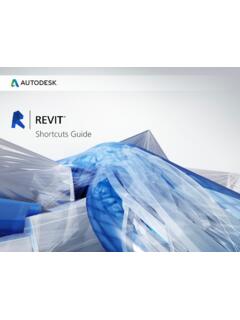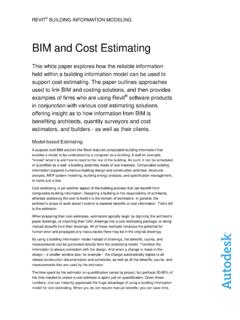Transcription of Autodesk Revit 2015 Getting Started Guide
1 A u t o d e s k R e v i t G e t t i n g S t a r t e d G u i d e | 1 Autodesk Revit 2015 Getting Started Guide A u t o d e s k R e v i t G e t t i n g S t a r t e d G u i d e | 2 2015 Autodesk , Inc. All Rights Reserved. Except as otherwise permitted by Autodesk , Inc., this publication, or parts thereof, may not be reproduced in any form, by any method, for any purpose. Certain materials included in this publication are reprinted with the permission of the copyright holder. Disclaimer THIS PUBLICATION AND THE INFORMATION CONTAINED HEREIN IS MADE AVAILABLE BY Autodesk , INC. AS IS. Autodesk , INC. DISCLAIMS ALL WARRANTIES, EITHER EXPRESS OR IMPLIED, INCLUDING BUT NOT LIMITED TO ANY IMPLIED WARRANTIES OF MERCHANTABILITY OR FITNESS FOR A PARTICULAR PURPOSE REGARDING THESE MATERIALS. Trademarks Autodesk , AutoCAD, DWG, Ecotect, and Revit are registered trademarks or trademarks of Autodesk , Inc.
2 , and/or its subsidiaries and/or affiliates in the USA and/or other countries. All other brand names, product names, or trademarks belong to their respective holders. Autodesk reserves the right to alter product offerings and specifications at any time without notice, and is not responsible for typographical or graphical errors that may appear in this document. Third Party Software Program Credits ACIS Copyright 1989-2001 Spatial Corp. Portions Copyright 2002 Autodesk , Inc. Copyright 1997 Microsoft Corporation. All rights reserved. International CorrectSpell Spelling Correction System 1995 by Lernout & Hauspie Speech Products, All rights reserved. InstallShield Copyright 1997 InstallShield Software Corporation. All rights reserved. PANTONE and other Pantone, Inc. trademarks are the property of Pantone, Inc. Pantone, Inc., 2002. Portions Copyright 1991-1996 Arthur D. Applegate. All rights reserved. Portions relating to JPEG Copyright 1991-1998 Thomas G.
3 Lane. All rights reserved. Portions of this software are based on the work of the Independent JPEG Group. Typefaces from the Bitstream typeface library copyright 1992. Typefaces from Payne Loving Trust 1996. All rights reserved. FME Objects Engine 2005 SAFE Software. All rights reserved. ETABS is a registered trademark of Computers and Structures, Inc. ETABS copyright 1984-2005 Computers and Structures, Inc. All rights reserved. RISA is a trademark of RISA Technologies. RISA-3D copyright 1993-2005 RISA Technologies. All rights reserved. Portions relating to TIFF Copyright 1997-1998 Sam Leffler. Copyright 1991-1997 Silicon Graphics, Inc. All rights reserved. Portions of Libxml2 Copyright 1998-2003 Daniel Veillard. All Rights Reserved. Government Use Use, duplication, or disclosure by the Government is subject to restrictions as set forth in FAR (Commercial Computer Software-Restricted Rights) and DFAR (Rights in Technical Data and Computer Software), as applicable.
4 Introductory Notes This Autodesk Revit Getting Started Guide was written using the 2015 version of this product and uses screen captures from the full Revit application that includes all disciplines (Architecture, Structure, and MEP). Please note that this tutorial may also be used with dedicated versions of Autodesk Revit Architecture or earlier versions of Revit going back to release 2012. Nomenclature used in this tutorial: Text entry required by user Bold Command, key entry, or button clicks ALL CAPS Selection of named items or elements Italics A u t o d e s k R e v i t G e t t i n g S t a r t e d G u i d e | 3 Table of Contents Topic Step series Page Getting Started 4 Understanding the Revit User Interface 8 Creating a Project Steps 01 - 05 15 Creating Walls Step 06 17 Creating Terrain Step 07 19 Adding Exterior Walls Step 08 22 Adding a Roof Step 09 24 Adding Floors Step 10 26 Adding Interior Walls Step 11 29 Adding Doors Step 12 32 Adding Windows Step 13 35 Adding a Curtain Wall Step 14 39 Attaching Walls to the Roof Step 15 40 Modifying the Entry Deck Step 16 43 Adding a Sloped Floor Step 17 45 Adding Stairs and Railings Step 18 47 Modifying the Roof Step 19 53 Documenting the Project Step 20 56 Creating a Solar Study Step 21 64 Creating a Sheet Step 22 67 Create a gbXML Export Step 23 69 Appendix.
5 Mouse Interface and Keyboard Shortcuts 73 Estimated time of completion of all steps: 4 8 hours hands-on A u t o d e s k R e v i t G e t t i n g S t a r t e d G u i d e | 4 Getting Started Understanding the Basics In this lesson, you learn what Autodesk Revit is and how its parametric change engine benefits you and your work. You begin with the fundamental concepts on which Revit is built. You learn the terminology, the hierarchy of elements, and how to perform some common tasks in the product. Understanding the Concepts What is Autodesk Revit 2015? The Revit platform for building information modeling is a design and documentation system that supports the design, drawings, and schedules required for a building project. Building information modeling (BIM) delivers information about project design, scope, quantities, and phases when you need it. In the Revit model, every drawing sheet, 2D and 3D view, and schedule is a presentation of information from the same underlying building model database.
6 As you work in drawing and schedule views, Revit collects information about the building project and coordinates this information across all other representations of the project. The Revit parametric change engine automatically coordinates changes made anywhere in model views, drawing sheets, schedules, sections, and plans. What is meant by parametric? The term parametric refers to the relationships among all elements of the model that enable the coordination and change management that Revit provides. These relationships are created either automatically by the software or by you as you work. In mathematics and mechanical CAD, the numbers or characteristics that define these kinds of relationships are called parameters; hence, the operation of the software is parametric. This capability delivers the fundamental coordination and productivity benefits of Revit : Change anything at any time anywhere in the project, and Revit coordinates that change through the entire project.
7 The following are examples of these element relationships: The outside of a door frame is a fixed dimension on the hinge side from a perpendicular partition. If you move the partition, the door retains this relationship to the partition. Windows or pilasters are spaced equally across a given elevation. If the length of the elevation is changed, the relationship of equal spacing is maintained. In this case, the parameter is not a number but a proportional characteristic. The edge of a floor or roof is related to the exterior wall such that when the exterior wall is moved, the floor or roof remains connected. In this case, the parameter is one of association or connection. A u t o d e s k R e v i t G e t t i n g S t a r t e d G u i d e | 5 How does Autodesk Revit 2015 keep things updated? A fundamental characteristic of a building information modeling application is the ability to coordinate changes and maintain consistency at all times.
8 You do not have to intervene to update drawings or links. When you change something, Revit immediately determines what is affected by the change and reflects that change to any affected elements. Revit uses 2 key concepts that make it especially powerful and easy to use. The first is the capturing of relationships while the designer works. The second is its approach to propagating building changes. The result of these concepts is software that works like you do, without requiring entry of data that is unimportant to your design. Element behavior in a parametric modeler In projects, Revit uses 3 types of elements: Model elements represent the actual 3D geometry of the building. They display in relevant views of the model. For example, walls, windows, doors, and roofs are model elements. Datum elements help to define project context. For example, grids, levels, and reference planes are datum elements. View-specific elements display only in the views in which they are placed.
9 They help to describe or document the model. For example, dimensions, tags, and 2D detail components are view specific elements. A u t o d e s k R e v i t G e t t i n g S t a r t e d G u i d e | 6 There are 2 types of model elements: Hosts (or host elements) are generally built in place at the construction site. For example, walls and roofs are hosts. Model components are all the other types of elements in the building model. For example, windows, doors, and cabinets are model components. There are 2 types of view-specific elements: Annotation elements are 2D components that document the model and maintain scale on paper. For example, dimensions, tags, and keynotes are annotation elements. Details are 2D items that provide details about the building model in a particular view. Examples include detail lines, filled regions, and 2D detail components. This implementation provides flexibility for designers. Revit elements are designed to be created and modified by you directly; programming is not required.
10 If you can draw, you can define new parametric elements in Revit . In Revit , the elements determine their behavior largely from their context in the building. The context is determined by how you draw the component and the constraint relationships that are established with other components. Often, you do nothing to establish these relationships; they are implied by what you do and how you draw. In other cases, you can explicitly control them, by locking a dimension or aligning 2 walls, for example. Understanding Autodesk Revit 2015 terms Most of the terms used to identify objects in Revit are common, industry-standard terms familiar to most architects. However, some terms are unique to Revit . Understanding the following terms is crucial to understanding the software. Project: In Revit , the project is the single database of information for your design the building information model. The project file contains all information for the building design, from geometry to construction data.




